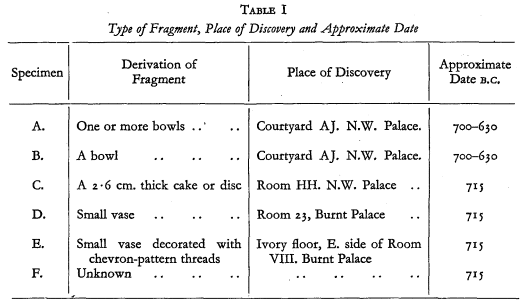Article contents
Glass Fragments from Nimrud of the Eighth to the Sixth Century B.C.
Published online by Cambridge University Press: 07 August 2014
Extract
Professor M. E. L. Mallowan, in his account of The Excavations at Nimrud (Kalḫu), 1951 makes four references to glass (two on p. 15, one each on pp. 18 and 19), three of them concerning glass fragments and one to the use of glass as an overlay. Two groups of these fragments were sent by him to Mr. D. B. Harden at the Ashmolean Museum, and Mr. Harden in turn passed them on to me for examination. Subsequently Professor Mallowan handed to me several other fragments. For the purpose of this account the material has been classified in six groups and labelled as specimens A to F. Each specimen may consist of a single fragment or of two or more closely related. Their character, their location when found, and the approximate date when they were deposited are summarised in Table I from information supplied by Professor Mallowan.

No inference should be drawn that the glass objects found were themselves of the dates quoted. They may have been contemporary or older.
- Type
- Research Article
- Information
- Copyright
- Copyright © The British Institute for the Study of Iraq 1955
References
1 Iraq, Vol. XIV, Pt. I.
2 On this point, Professor Mallowan in a letter to me dated August 7th, 1954, says: “The weight of the archaeological evidence may lead one to suspect that the objects in question are not much older than the dates assigned … at Nimrud traces of glass only become common in occupation levels of the eighth and seventh centuries B.C.”
3 Mallowan, M. E. L., Iraq, Vol. XVI, Pt. I, p. 83Google Scholar.
4 See, for example, Fossing, P., Glass Vessels before Glass Blowing, (1940), 13, 17 and 18Google Scholar.
5 Z. angew. Chem, 1939, 42, 835Google Scholar.
6 loc. cit.
7 Iraq, Vol. III, Pt. 1, pp. 87–88Google Scholar.
8 publ. Dulac & Co., London.
9 Clarendon Press, Oxford.
10 Iraq, Vol. XVI, Pt. 1, pp. 77 and 83Google Scholar.
11 Iraq, Vol. XVI, Pt. 1, pp. 77 ffGoogle Scholar.
12 Z. angew. Chem. 1925, 38, 776 and 857Google Scholar.
13 The museum of Far Eastern Antiquities, Bulletin No. 10 Stockholm, 1938, 1–64.
- 5
- Cited by


